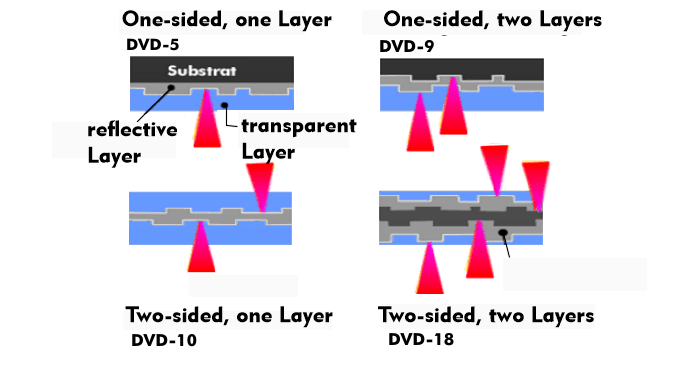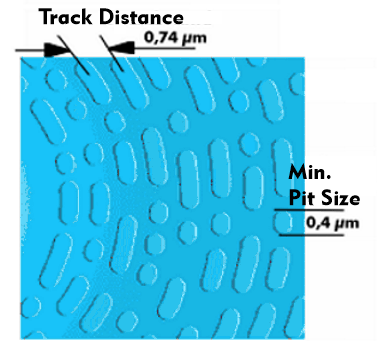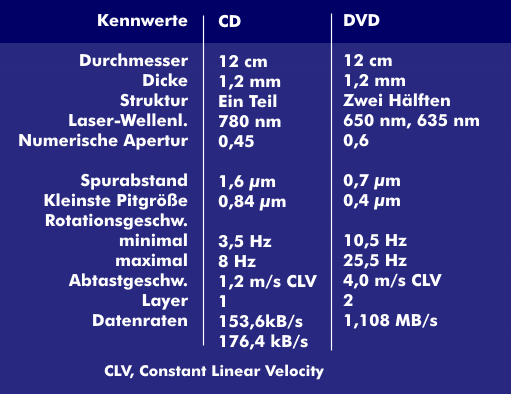digital versatile disc (DVD)
DVD stands for Digital Versatile Disc, which indicates its versatility. The DVD is intended to replace both conventional compact discs(CD) and video tapes as storage media. This shiny silver plastic disc, 12 cm in diameter, or 8 cm as a mini DVD, is similar in appearance and dimensions to the compact disc (CD), to which it is also backward compatible.
The DVD has a much higher storage capacity than the compact disc. It can be up to 17 GB in size. This is due on the one hand to the double-sided construction and layer structure, but also to the higher storage density, which is due to the shorter wavelength of the red light laser.
A DVD can be single-sided or double-sided and equipped with one or two recording layers. A double-sided DVD consists of two 0.6 mm thick half-disks glued to each other with storage surfaces on both sides. Each storage surface can in turn consist of two storage layers. Several different DVD types with different storage capacities are therefore available, with the type designation containing the storage capacity: DVD-5 with 4.7 GB, DVD-9 with 8.5 GB, DVD-10 with 9.4 and DVD-18 with 17 GB. Among the smaller DVDs, the mini DVDs, there are the DVD-1, the DVD-2, the DVD-3 and the DVD-4.
A further increase in storage capacity is achieved by using a short-wave red laser with a wavelength of 650 nm (635 nm) and a numerical aperture( NA) of the lens of 0.6. Unlike the compact disc, the shorter wavelength laser light is used to burn a smallest pit size of only 0.4 µm, resulting in a track pitch of only 0.74 µm.
Data is stored in spiral tracks from the inside out, alternating between pits and lands in the dye, an organic dye. Depending on the type of DVD, data storage occurs on one or both sides and in one or both storage layers. Since the respective upper storage layer is semi-transparent, both superimposed layers of a storage surface can be scanned with laser optics, depending on which layer the laser is focused on. This process of alternating between the two layers is known as the phase-change process.
The differences to the compact disc
As with the compact disc, the DVD has different formats that are read-only, others that are recordable once, and still others that are recordable and rewritable many times. The best known formats are the read-only versions DVD-Video, DVD-Audio and DVD-ROM and the write-only versions DVD-R, DVD-RW, DVD+RW and DVD-RAM. While DVD-ROM was standardized as early as 1996, no agreement has yet been reached on the DVD write standard. Here, the incompatible DVD-RAM, DVD-R, DVD-RW and DVD+RW compete for standardization. DVD specifications are developed and monitored by the DVD Forum, in which all well-known companies are represented.
As far as the service life specifications of the DVD are concerned, it was said in the 1990s that this was unlimited. In the meantime, the service life specifications have been revised further and further downwards and are now around 15 to 10 years. Since the manufacturers do not make any reliable statements about how long DVDs can reliably store data, this medium is less suitable for archiving and for long-term archiving.



